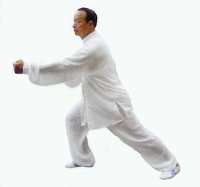
Zeng Nailiang’s Xin style Taiji
Parry and Punch
The positive effects of Tai Chi Chuan training on balance and stability are well known. Clinical studies have shown that, with as little as a few weeks of Tai Chi practice, students are significantly less likely to fall down accidentally, inside or outside of class. From a martial arts perspective, they are also less vulnerable to trips, throws and takedowns.
Not every slow-motion exercise routine is worthy of the name Tai Chi, though. The subtle details of your performance will determine whether your practice is excellent balance training, or just marginally beneficial. Here are three adjustments to enhance your Tai Chi form practice for improved balance:
- Minimize the time spent standing on both legs. In order to move, you must lift a leg, and in order to lift a leg, you must not be using it to support your weight. Since the Tai Chi form is essentially continuous movement, there should never be a pause wherein each leg carries 50% of your body weight. Moments of even-weightedness (which some call “double-weightedness”) should be made as brief as possible.
- Empty your rear leg on front-weighted postures. Typically, Tai Chi instructors will teach their students to “empty” the front leg completely on back-weighted postures; that is, to place the entire weight on the back leg. On front-weighted postures, however, they will recommend leaving 30% of the body weight on the back leg. While this practice is not incorrect, it is not ideal balance training either. Transferring your weight completely for postures such as Brush Knee and Twist Step or Parry and Punch will challenge your stability; it will also help to dispel any internal confusion between stance training and rootedness. If your weight is fully shifted to the front, lifting your back leg should not cause your torso to move.
- Lift your foot flat off the ground. This is another adjustment from orthodox form practice. While standard Tai Chi footwork uses a natural rolling step—first the back heel is lifted, then the ball and finally the toes—lifting the entire surface of the foot at once will force you to empty it first. If not, you’ll fall backwards.
Following these guidelines will clarify your Tai Chi footwork, which in turn will increase your balance, stability, and overall ease of movement.
Have you modified your forms to cultivate balance, or any other attribute?
Those are some great tips! Balance for me seems easier after pole standing warm-ups, but to get that balance in motion is really the ticket.
I am not sure if people have seen the most recent Stanford Univeristy Study on a Tai Chi Master who can hit 14x his own body weight. The link can be found by following:
http://ledgergermane.com/post/34241832
Hope that is of interest to folks who want to see current research on the martial benefits of advanced training.
Good blog and this is a good topic. I do wish more elderly people would be involved in the arts. I know in my school they only pay a $5 per month fee since most are on a low fixed income. They take very little of the instructors time and are very good for the younger student in the class.
Thanks,
Tony (a href=”http://www.themmazone.net/index.php?pr=Uniforms”>Martial Arts for the Elderly!) Hackson
Ah..
Lifting the foot up flat to empty the leg is also the “Mud step” in bagua…
D.R.
Sydney, that is an impressive number. The boxing instructor in the Fight Science documentary could generate only 1000 pounds of force.
Dojo Rat, should step 4 be “take up Bagua instead”? Wang Xiangzhai might agree with that. 😉
Good Stuff!!!
Nice post. Tai Chai requires intensive practices and proper training is mostly needed. Spiritually Tai Chai practice drives ones energy. Your training tips are incredible. There are different style of Tai chai arts are followed and their techniques are also distinct. Footwork is a important part of Tai chai and I think guidelines will be useful.